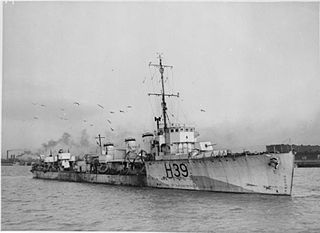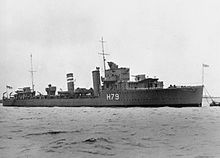
HX convoys were transatlantic convoys in the North Atlantic during the First World War and in the Battle of the Atlantic in the Second World War. HX convoys sailed eastwards from Halifax, Nova Scotia in Canada, to Liverpool and other ports in Britain. They were joined the BHX convoys from Bermuda en route. After the United States entered the war, HX convoys began at New York.

HMS Duncan was a D-class destroyer leader built for the Royal Navy in the early 1930s. The ship was initially assigned to the Mediterranean Fleet before she was transferred to the China Station in early 1935 where she remained until mid-1939. Duncan returned to the Mediterranean Fleet just after World War II began in September 1939. She was transferred to the Home Fleet in December 1939, although she was badly damaged in a collision the following month, and required repairs that lasted until July 1940. The ship joined Force H at Gibraltar in October, escorting the larger ships and various convoys until March 1941 when she was transferred to West Africa for convoy escort duties for a few months. Duncan rejoined the 13th Destroyer Flotilla at Gibraltar in July and escorted several convoys to Malta during the rest of the year. After a refit, she briefly returned to the 13th Destroyer Flotilla before joining the Eastern Fleet in the Indian Ocean to participate in Operation Ironclad in May 1942. The ship was recalled home to be converted into an escort destroyer in late 1942.
Escort Group B2 was a convoy escort British formation of the Royal Navy which saw action during the Second World War, principally in the Battle of the Atlantic. The group was under the command of Cdr Donald Macintyre, one of Britain's most successful anti-submarine warfare commanders.
ONS 5 was the 5th of the numbered ONS series of Slow trade convoys Outbound from the British Isles to North America. The North Atlantic battle surrounding it in May 1943 is regarded as the turning point of the Battle of the Atlantic in World War II. The battle ebbed and flowed over a period of a week, and involved more than 50 Allied ships and their escorts, and over 30 U-boats. It saw heavy losses on both sides. However it was almost the last Allied convoy to do so, while losses inflicted on attacking U-boats and U-boat groups became a besetting feature of the campaign; As such it is seen as the point when the tactical and strategic advantage passed to the Allies, and ushered in the period known to Nazi Germany's Kriegsmarine as Black May.
The ON and later ONS convoys were a series of North Atlantic trade convoys running Outbound from the British Isles to North America during the Atlantic campaign of the Second World War. The ON convoys replaced the earlier OA/OB series of outbound convoys in July 1941 and ran until the end of the campaign in May 1945. They were organized as alternating fast and slow convoys until March 1943, when the ONS series was begun to take over the slow trans-Atlantic traffic, after which all in the ON series were fast.
HMS Marigold was a Flower-class corvette of the Royal Navy. She was launched on 4 September 1940 and was sunk by an Italian air-dropped torpedo on 9 December 1942.
Convoy SC 42 was the 42nd of the numbered series of World War II Slow Convoys of merchant ships from Sydney, Cape Breton Island to Liverpool. SC 42 was attacked over a three night period in September 1941, losing 16 ships sunk and 4 damaged. This was the worst Allied loss following the attack on convoy SC 7 the previous year. Two attacking U-boats were destroyed.

Convoy SC 130 was a North Atlantic convoy which ran during the battle of the Atlantic in World War II. It was the 130th of the numbered series of Slow Convoys of merchant ships from Sydney, Cape Breton Island to Liverpool. SC 130 was one of several convoy battles that occurred during the crisis month of May 1943.

Mid-Ocean Escort Force (MOEF) referred to the organisation of anti-submarine escorts for World War II trade convoys between Canada and Newfoundland, and the British Isles. The allocation of United States, British and Canadian escorts to these convoys reflected preferences of the United States upon United States' declaration of war and the organisation persisted through the winter of 1942–43 despite withdrawal of United States ships from the escort groups. By the summer of 1943, United States Atlantic escorts were focused on the faster CU convoys and the UG convoys between Chesapeake Bay and the Mediterranean Sea; and only British and Canadian escorts remained on the HX, SC and ON convoys.
ONS 20 and ON 206 were North Atlantic convoys of the ONS/ON series which ran during the battle of the Atlantic in World War II. They were the subject of a major U-boat attack in October 1943, the third battle in the Kriegsmarine's autumn offensive.

HMS Orchis was a Flower-class corvette that served in the Royal Navy during World War II.

Western Local Escort Force (WLEF) referred to the organization of anti-submarine escorts for World War II trade convoys from North American port cities to the Western Ocean Meeting Point near Newfoundland where ships of the Mid-Ocean Escort Force (MOEF) assumed responsibility for safely delivering the convoys to the British Isles.
ON 207 was a North Atlantic convoy of the ONS/ON series which ran during the Battle of the Atlantic in World War II. It was the subject of a major U-boat attack in October 1943, the fourth battle in the German autumn offensive.

Vice Admiral Sir Peter William Gretton was an officer in the Royal Navy. He was active in the Battle of the Atlantic during the Second World War, and was a successful convoy escort commander. He eventually rose to become Fifth Sea Lord and retired as a vice admiral before entering university life as a bursar and academic.

An Escort Group consisted of several small warships organized and trained to operate together protecting trade convoys. Escort groups were a World War II tactical innovation in anti-submarine warfare by the Royal Navy to combat the threat of the Kriegsmarine's "wolfpack" tactics. Early escort groups often contained destroyers, sloops, naval trawlers and, later, corvettes of differing specifications lacking the ability to maneuver together as a flotilla of similar warships, but rigorously trained in anti-submarine tactics to use teamwork emphasizing the unique sensors, weapons, speed, and turning radius of each ship. The development of these 'escort groups' proved an effective means of defending shipping convoys through the Battle of the Atlantic.
Escort Group B6 was a British convoy escort group of the Royal Navy which saw action during the Second World War, principally in the Battle of the Atlantic.

Convoy ON 144 was a trade convoy of merchant ships during the Second World War. It was the 144th of the numbered series of ON convoys Outbound from the British Isles to North America. The ships departed Liverpool on 7 November 1942 and were joined on 8 November by Mid-Ocean Escort Force Group B-6 consisting of the Flower-class corvettes Vervain, Potentilla, Eglantine, Montbretia and Rose and the convoy rescue ship Perth. Group B-6 had sailed without the destroyers Fame and Viscount which had been damaged in the battle for eastbound convoy SC 104. The United States Coast Guard cutters Bibb, Duane, and Ingham accompanied the convoy from the Western Approaches with ships that detached for Iceland on 15 November.

HMS Alisma was a Flower-class corvette that served in the Royal Navy.

HMS Sunflower was a Flower-class corvette of the Royal Navy. She served during the Second World War.

HMS Dianella was a Flower-class corvette of the Royal Navy. She served during the Second World War.












